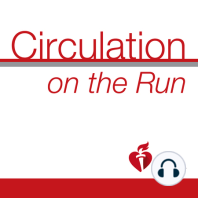17 min listen
Circulation April 18, 2023 Issue
ratings:
Length:
22 minutes
Released:
Apr 17, 2023
Format:
Podcast episode
Description
This week, please join authors Marc Sabatine and Prakriti Gaba, as well as Associate Editor Amit Khera, as they discuss the article "Association Between Achieved Low-Density Lipoprotein Cholesterol Levels and Long-Term Cardiovascular and Safety Outcomes: An Analysis of FOURIER-OLE." Dr Greg Hundley: Welcome listeners, to this April 18th issue of Circulation on the Run and I am Dr. Greg Hundley, Associate Editor, Director of the Pauley Heart Center at VCU Health in Richmond, Virginia. Dr Peder Myhre: And I'm Dr. Peder Myhre, Social Media Editor from Akershus University Hospital and University of Oslo. Dr Greg Hundley: Peder, today's feature discussion, very interesting. We're going to evaluate the association between what's achieved with LDL cholesterol lowering, and then also long-term cardiovascular and safety outcomes. But before we get to that, how about we grab a cup of coffee and discuss some of the other articles in the issue? Would you like to go first? Dr Peder Myhre: Yes, Greg. I would love to. And the first paper is from the World of Preclinical Science and it comes to us from corresponding author, Jan Magnus Aronsen from University of Oslo in Norway. And perhaps, as you know, Greg, cardiomyocyte contraction and relaxation depend on the activity of the sarcoplasmic reticulum CA+2 ATPase 2, abbreviated SERCA2, and lowered levels or reduced activity of SERCA2, as seen in chronic heart failure, weakens contractile force and delays relaxation and no available therapy involves direct manipulation of the SERCA2 activity. And Greg, phosphodiesterase 3A is proposed to be present in the SERCA2 interactome limit SERCA2 activity and disruption of phosphodiesterase 3A from SERCA2 might thus be a strategy to develop SERCA2 activators. And in this study, the authors investigated and mapped SERCA2 and phosphodiesterase 3A and assessed this in experiments assessing the binding between these two in cardiomyocytes and in vesicles. Dr Greg Hundley: Wow Peder, sounds very interesting. So what did they find and how about the clinical implications of the findings? Dr Peder Myhre: So Greg phosphodiesterase 3A bounded directly to SERCA2 in the cardiomyocyte. So that's the first finding. Second, they demonstrated that SERCA2 phosphodiesterase 3A disruption increased SERCA2 activity independently of the catalytic activity of phosphodiesterase 3A in both normal and failing cardiomyocytes. And third, SERCA2 activity by the optimized SERCA2 phosphodiesterase 3A disruptor peptide OPT F reduced mortality and improved contractility after aortic binding in mice. So the clinical implication is that direct targeting of phosphodiesterase 3A binding to SERCA2 could be a novel approach to increase SERCA2 activity and thus cardiac contractility in patients with heart failure. Dr Greg Hundley: Very nice Peder. What a great new finding in the world of preclinical science. Well my paper is going to delve into the world of clinical science and involves patients with stroke. So Peder in this study led by corresponding author, Dr. Dileep Yavagal from University of Miami Miller School of Medicine performed a survey in 75 countries through the Mission Thrombectomy 2020+ Global Network between November of 2020 and February of 2021 to determine the availability of mechanical thrombectomy for large vessel occlusion in patients with stroke. Now Peder, the primary endpoints were the current annual mechanical thrombectomy availability, the mechanical thrombectomy operator availability and the mechanical thrombectomy center availability. All of these availabilities were defined as the proportion of estimated large vessel occlusion for patients receiving mechanical thrombectomy in a given region annually. Dr Peder Myhre: Okay, Greg, so this is really an access question. So in essence, what is the availability of mechanical thrombectomy worldwide? So what did they find? Dr Greg Hundley: Right, great Peder. So what they found, the authors received 887 res
Released:
Apr 17, 2023
Format:
Podcast episode
Titles in the series (100)
Circulation January 24, 2017 Issue: Circulation Weekly: Your Weekly Summary & Backstage Pass To The Journal by Circulation on the Run
